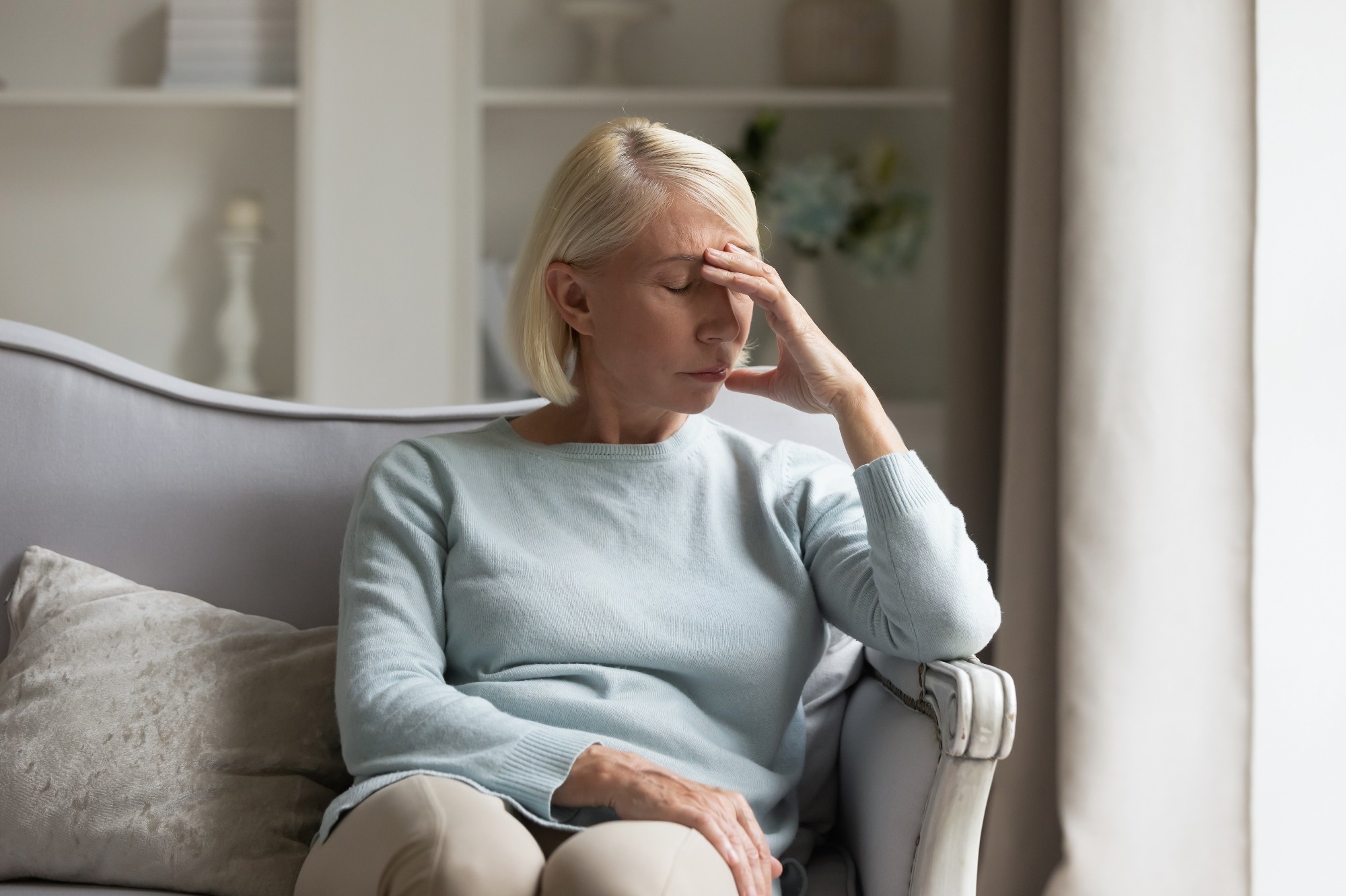Causes and mechanism
Risk factors
Management
References
Further reading
Fatigue is a common symptom in oncology patients that can lower their quality of life. It can affect the patients through the different stages of carcinoma. Cancer fatigue elevates during treatment and can also be seen in patients during survivorship.
 Fatigue. Image Credit: fizkes/Shutterstock.com
Fatigue. Image Credit: fizkes/Shutterstock.com
Patients suffering from cancer fatigue can experience low energy and motivation, reduced concentration, and weakness, among others. The literature suggests that cancer fatigue might be an under-reported and under-treated condition.
Around 50-90% of oncology patients worldwide may struggle with cancer-related fatigue. Depending on the patient demographic, the type of treatment, and the assessment method, the prevalence of weariness during treatment can vary between 25-99%.
According to most research, 30% to 60% of patients experience moderate to severe tiredness throughout therapy, which could occasionally result in treatment termination.
However, 25–30% of people continue to feel tired years after adequate treatment. According to analyses of cancer survivors, fatigue may linger for up to five years after treatment is over, and maybe even longer.
Moderate to severe fatigue was expected in 21-52% of breast cancer patients post-diagnosis. In the case of adolescent and young adult cancers, 25% of survivors can experience chronic fatigue for up to 5 to 30 years post-diagnosis.
Chronic cancer fatigue has also been observed in a significant proportion of patients with cervical, lymphoma, and gastrointestinal cancers. Young cancer survivors have reported more instances of cancer fatigue.
Causes and mechanism
Possible central and/or peripheral neural systems disruptions may cause cancer fatigue. Cancer and its treatments have the ability to stimulate the peripheral pro-inflammatory cytokine network, which causes cancer fatigue symptoms by signaling cytokines in the brain.
Neuroinflammation has also been proposed as a potential explanation for the persistence of cancer tiredness. The hypothalamic-pituitary-adrenal (HPA) axis, the circadian rhythm, serotonin, and vagal afferent nerve activity are some of the theories surrounding central processes.
Theories about ATP and the contractile capabilities of muscles are examples of peripheral mechanisms.
In addition to suppressing the HPA axis, various cancer therapies such as glucocorticoids, radiation, and some chemotherapy medications may also lower energy levels due to the dampened stress response.
Circadian rhythms and quality of life are significant indicators of the prognosis for cancer. Cortisol levels in healthy people follow a daily rhythm similar to the rest-activity cycle.
Changes in circadian rhythms and altered diurnal cortisol secretion are both signs of HPA axis dysfunction, which has been connected to exhaustion and enhanced cytokine signaling. Cancer or its treatment undoubtedly has an impact on this system and alters a person's arousal or sleep cycles.
Cancer patients who are fatigued have dramatically changed circadian cortisol levels; hence, increased fatigue is correlated with flatter diurnal slopes and a shorter evening cortisol fall.
Cancer Related Fatigue
Risk factors
Several risk factors associated with fatigue in cancer have been proposed in the literature. Single nucleotide polymorphisms (SNPs) in inflammation-related genes, such as IL1B, IL6, and TNFA, are connected to weariness brought on by cancer treatment.
Pretreatment fatigue is the most reliable and consistent predictor of post-treatment tiredness across trials. Patients who express more significant levels of tiredness before radiotherapy and chemotherapy also express more significant levels of fatigue immediately following treatment.
Elevated BMI, lack of physical activity, depression, and sleep disturbances have also been linked with fatigue in cancer patients.
Management
For patients and clinicians alike, effective CRF treatment is crucial. The patient’s history, physical examination, and assessment of the likelihood that they would receive cancer therapy are all included in the initial evaluation.
Following the assessment of fatigue and primary evaluation, along with re-evaluation at regular intervals while receiving therapy, the patient's cancer-associated fatigue treatment or intervention is planned.
Both pharmaceutical and nonpharmacological therapies may benefit those with moderate or severe fatigue.
Chemotherapy patients have been shown to benefit from psychostimulant medications like methylphenidate. However, there are worries regarding their side effect profile and potential for addiction in survivors.
A wide range of tumor forms, including solid and non-myeloid hematologic malignancies, have responded favorably to the use of ESA (erythropoietin-stimulating agents) therapy.
Patients' general quality of life, energy level, level of exercise, and level of weariness all saw significant improvements. On the other hand, new research indicates that ESA-treated patients can develop venous thrombosis.
In light of each patient's clinical situation, weighing the risks and advantages of using an ESA is necessary. Whether modafinil, L-carnitine, and dexamethasone can help fatigued oncology patients is being researched.
Non-pharmacological interventions include cognitive-behavioral therapy (CBT), regular physical exercises, cardiovascular training, proper rest and sleep, and a healthy diet. Intake of appropriate nutrients, a good night's sleep, and physical activity like aerobic walking and aerobic cycling can help provide better outcomes.
References
- Bower JE (2014). Cancer-related fatigue--mechanisms, risk factors, and treatments. Nature reviews. Clinical oncology, 11(10), 597–609. doi: 10.1038/nrclinonc.2014.127
- Saligan LN, Olson K, Filler K, Larkin D, Cramp F, Yennurajalingam S, Escalante CP, del Giglio A, Kober KM, Kamath J, Palesh O, Mustian K, & Multinational Association of Supportive Care in Cancer Fatigue Study Group-Biomarker Working Group (2015). The biology of cancer-related fatigue: a review of the literature. Supportive care in cancer: official journal of the Multinational Association of Supportive Care in Cancer, 23(8), 2461–2478. doi: 10.1007/s00520-015-2763-0
- Cramp F & Byron-Daniel J (2012). Exercise for the management of cancer-related fatigue in adults. The Cochrane database of systematic reviews, 11(11), CD006145. doi: 10.1002/14651858.CD006145.pub3
- Minton O, Berger A, Barsevick A, Cramp F, Goedendorp M, Mitchell SA & Stone PC (2013). Cancer-related fatigue and its impact on functioning. Cancer, 119 Suppl 11, 2124–2130. doi: 10.1002/cncr.28058
- Thong MSY, van Noorden CJF, Steindorf K & Arndt V (2020). Cancer-Related Fatigue: Causes and Current Treatment Options. Current treatment options in oncology, 21(2), 17. doi: 10.1007/s11864-020-0707-5
- Mohandas H, Jaganathan SK, Mani MP, Ayyar M & Rohini Thevi, GV (2017). Cancer-related fatigue treatment: An overview. Journal of cancer research and therapeutics, 13(6), 916–929. doi: 10.4103/jcrt.JCRT_50_17
Further Reading